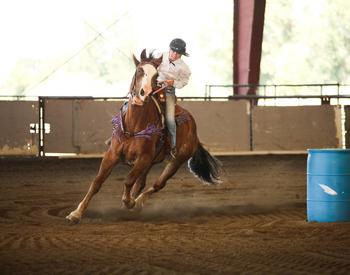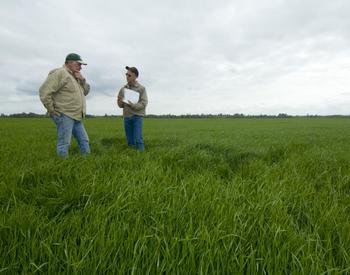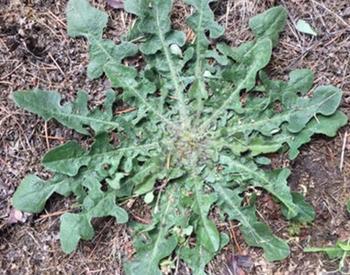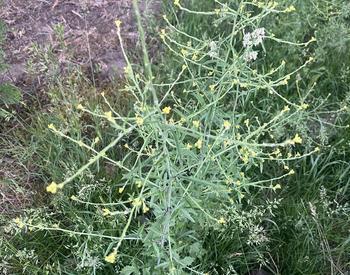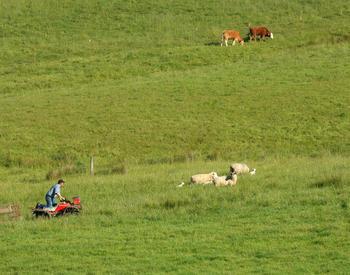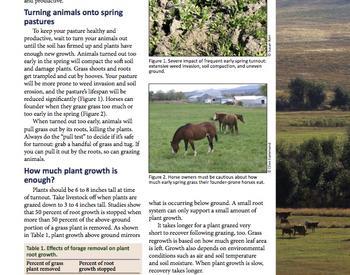“What do you mean my cow/horse/sheep/goat/ llama/alpaca/elephant died of starvation? She had all the hay she could eat!”
Sadly, these words are sometimes uttered by livestock owners experiencing a painful lesson about hay quality. Some poor-quality hay (Photo 1) can’t supply basic nutritional requirements or allow for proper growth, lactation, pregnancy or work.
However, livestock owners can avoid these problems by understanding basic principles related to hay, legume, mixed-grass or legume hay.
Quality affected by harvest time
Two crucial components of hay quality are protein content and fiber content. As depicted in Table 1, protein content decreases and fiber content increases with increasing grass maturity. Grass harvesting is a compromise between quality and quantity because the two are inversely related. Early harvested grass will be high quality (higher protein content, lower fiber content, and higher fiber digestibility) but the hay yield will be low. Late-harvested grass will be lower quality (lower protein content, higher fiber content, and lower fiber digestibility), but more hay tonnage will be harvested.
Grass harvest time is affected by weather and soil conditions. Harvest must be delayed until soils are dry enough so harvesting equipment does not get stuck and mowing, raking and baling activities will not excessively damage soils. Reed canary grass is a prolific grass that does well in wet areas, but the crop is often mature before it can be harvested. There may be a great amount of harvested grass, but its quality will be even less than that of the “dough phase” shown in Table 1.
| Maturity | CP | ADF | NDF |
|---|---|---|---|
| Veg-Boot | > 18 | < 33 | < 55 |
| Boot-early Head | 13-18 | 34-38 | 55-60 |
| Head-Milk | 8-12 | 39-41 | 61-65 |
| Dough | < 8 | > 41 | > 65 |
Fiber content and hay quality
Neutral detergent fiber includes all types of plant cell fiber: cellulose, hemicellulose, and lignin, and a low number is desirable. Acid detergent fiber includes the less digestible parts of plant cell fiber — cellulose and lignin — and a low number is desirable. Both types of fiber increase with increasing plant maturity. Photo 2 is a visual metaphor of a plant cell using a cardboard box to represent the outer cell wall (cellulose; digestible), plastic bag to represent the lignin layer (completely indigestible), paper wrapping to represent the inner cell wall (hemicellulose; digestible), and sugar to represent cell contents (sugars, protein, fat, pectin, and starch; extremely digestible).
Reed canary grass can easily be 5 to 6 feet tall when the soil is dry enough for heavy equipment. Plants this tall need to produce more structural fiber — lignin — to stand up, and lignin is indigestible. Neutral and acid detergent fiber of mature reed canary grass will be very high, so both feed intake and digestibility will be reduced.
- Desirable Hay Fiber Levels:
- NDF: <50%
- ADF: <35%
Protein content and hay quality
The protein content of grasses decreases as plant mature. Young plants — even reed canary grass — can have impressive crude protein levels — sometimes exceeding 20% on a dry basis. For ruminants, the lowest amount of crude protein needed for survival is 7%. Below this, there is insufficient protein for rumen microbes to reproduce, so fiber digestion ceases. The ruminant will be hungry and ingest more feed, but the fiber will be indigestible, the rumen will fill and stay full, and the animal can starve to death with a full stomach.
Fresh forage vs. hay
Lush spring grass pasture can have high protein content and high fiber digestibility. But it will also have high water content — as much as 90% of grass weight will be water in early spring. As shown in Table 2, livestock grazing on spring pasture grass will need a great deal more fresh forage to meet its nutritional requirements than livestock eating hay, from which most water weight has been removed.
| Forage Type | % water | % dry matter | # forage |
|---|---|---|---|
| Fresh forage | 90 | 10 | 360 |
| Hay | 10 | 90 | 40 |
How to prevent full belly death
The only way to know the nutritional value of hay is to test it. The resources shared below describe how to take a forage sample for analysis, where to send it, and how to interpret results. The testing laboratory, Extension educators, veterinarians and livestock nutrition consultants can also help with interpreting and using the information contained in forage analysis reports.
Photo 3 is an example of a low-quality grass hay report from a forage analysis laboratory. Note its very low crude protein content and high acid and neutral detergent fibers and lignin levels. Its relative feed value (RFV) is 77.67. Mature alfalfa hay has a relative feed value of 100.
Relative feed value is a way to compare the expected intake and digestibility of various roughages — a higher number is better. Low-quality hay can be included in livestock rations if supplements are provided to meet animals’ energy, protein, vitamin and mineral requirements. If provided as the sole feed, low-quality hay such as that in Photo 3 cannot maintain any species of livestock at any life stage. Ruminants need a fibrous diet to keep their rumens working well, so savvy producers use inexpensive, low-quality forage as a ration foundation, adding grain for energy and lick tubs, barley cakes, dry peas or a little alfalfa for protein. Body condition scoring, growth rates, milk production, and general health can help assess the effectiveness of a nutritional program.
Conclusion
Just as one would not expect a baby to grow well or a triathlete to perform well on a diet of high-fiber/low-calorie rice cakes, most livestock cannot perform well or remain healthy on low-quality fiber diets. No matter how much low-quality forage they consume, they will not be able to meet their nutritional requirements. As a result, they will use body reserves of energy and protein until death ensues. If inexpensive low-quality hay must be incorporated into livestock rations, producers should supplement the ration with nutrients needed to meet their livestock’s’ nutritional requirements.
Resources





